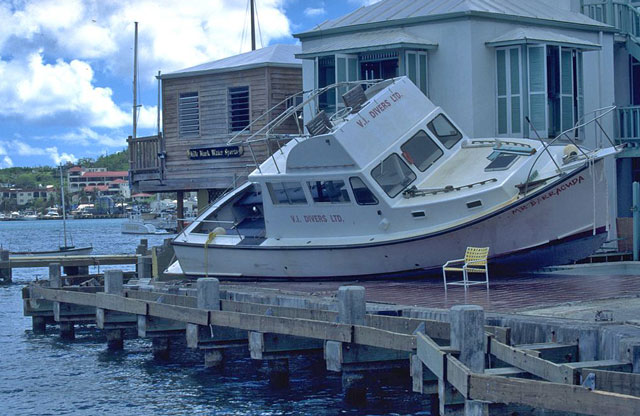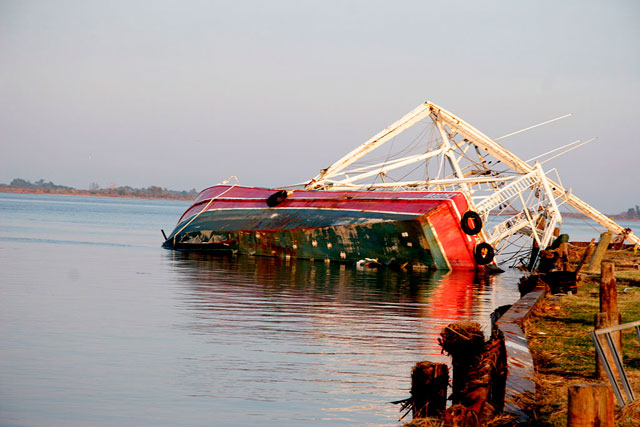Advertisement
Advertisement
Five Docking Disasters: Don’t Let This Happen to You!
Be on guard for these docking disasters every time you approach the pier.
May 12, 2014
Hopefully you've already read How to Dock a Boat: Our Top 10 Tips, in your quest to become a better boater. But let’s face facts: docking is one of the most stressful events we go through in a day of boating. There’s the potential to do some serious damage to your boat, the dock, or both. When wind and current are involved, it’s one of the trickiest maneuvers you’ll have to contend with in the course of captaining your boat. And of course, everyone’s watching.
Most of the time, we pull safely into the slip and then breathe a sigh of relief. If, that is, none of these five docking disasters occur. Be on the lookout, and don’t let them happen to you.
1. The Cable Conundrum – You may shift your boat in and out of gear 10,000 times with no problem, but Murphy’s law dictates that when the cable finally snaps, it’ll happen as you’re approaching the dock. Or, maybe it’ll be steering cable failure. Either way you’re going to have to spring into action, and fast. Hopefully you weren’t approaching the dock at warp speed—remember that the number-one rule of docking is to never approach the pier any faster than you’re willing to hit it. Grab a fender (life jackets work in a pinch) and determine which part of the boat is likely to impact the dock. Then hold the fender over the side, changing its position as necessary, to buffer the bump. As you do so, remember that if you bounce off with too much force you won’t have a way to get back to the dock; crewmembers should attempt to get a line around a piling or a cleat as fast as possible. Finally, shout a warning to everyone around NOT to attempt to fend with their hands or feet unless you’re in a very small boat that’s moving slowly. Otherwise, someone could get a body part between the boat and the pier, and significant injury could result. Oh, and one more thing—in the future, make sure you give all those cables the once-over now and again, to ensure they’re in good shape.
2. Power Failure – Could your boat possibly pick a worse time to stall? Nope. And that means it almost certainly will, right at a critical moment. You have to always be prepared for a power loss, and ready to react to it much in the same way as described above. In this case, however, there’s a chance to regain control—so don’t leave the helm. Instead, as you try to re-start the engine direct your crew to tend to fending. Also, remember that as long as the boat is in motion you do retain some degree of steerage. While you may not be able to direct the boat as you’d like, you can cut the wheel all the way in one direction or the other, to swing the boat broad-side to the pier or aim the nose into a slip.
3. All Wrapped Up – One thing about docks: there are lines all over the place. And if someone left a lire or two hanging off the dock or a piling and you don’t see it, you might drive over it and wrap the prop. Look out for this danger to arise in high-current areas, where a line may be stretched out across the mouth of a slip or off the end of the dock. If you have an outboard or stern drive and you do get wrapped, cut all power, raise the drive, and spin the prop backwards by hand to unwind the line. If you have an inboard you’ll probably have to go for a swim to get the line free. But never try this while your boat is still floating around unsecured. Instead, use a boathook or gaff to snag the line, and pull your boat close enough to the dock or a piling to tie it up at least temporarily.
4. Splash and Crash – It happens all the time: you pull your boat into the slip or next to the dock, and someone decides to jump up onto the pier. But they miscalculate or slip, and SPLASH! This is a recipe for serious disaster, because there are lots of solid objects, like pilings, planks, and the side of the boat, which can interrupt the person’s fall and turn it into an injury. But you can prevent this from ever happening by giving your crew clear instructions ahead of time. Tell everyone to keep their feet on the boat until it's secure, and if you moor in a slip where stepping off is necessary, ask them not to jump off until you give a green light. Then maneuver the boat as close to the pier as possible before giving the go-ahead.
5. The Premature Power Down – One of the most common ways a good docking job turns into a disaster is self-inflicted: when the captain sees his crew has the lines in-hand, and shuts down the engines prematurely. Then, someone drops a line or sets it down for a second, and it falls overboard. Now toss a sudden gust of wind or a few knots of current into the mix, and what was a successful maneuver can quickly get out of hand. The solution is simple—don’t power down until all of the lines are secured to the appropriate cleats. Added bonus: as long as you’re at the helm with the engines running, you can lend a hand to crewmembers who are tugging for all they’re worth, by bumping the boat in and out of gear to take the strain off the line.
Does docking still have you flummoxed? Be sure to check out these other articles and videos on the topic:
How to Use a Spring Line
How to Select and Maintain Dock Lines
How to Dock a Powerboat Side-to
Docking Defense
Docking Under Sail
Advertisement
Advertisement













